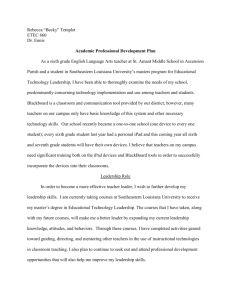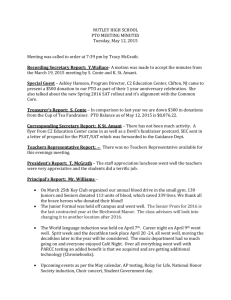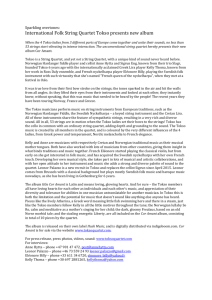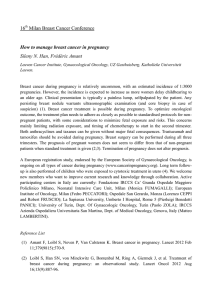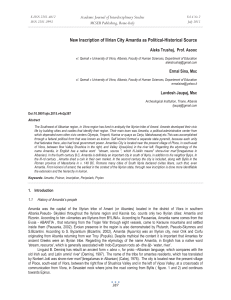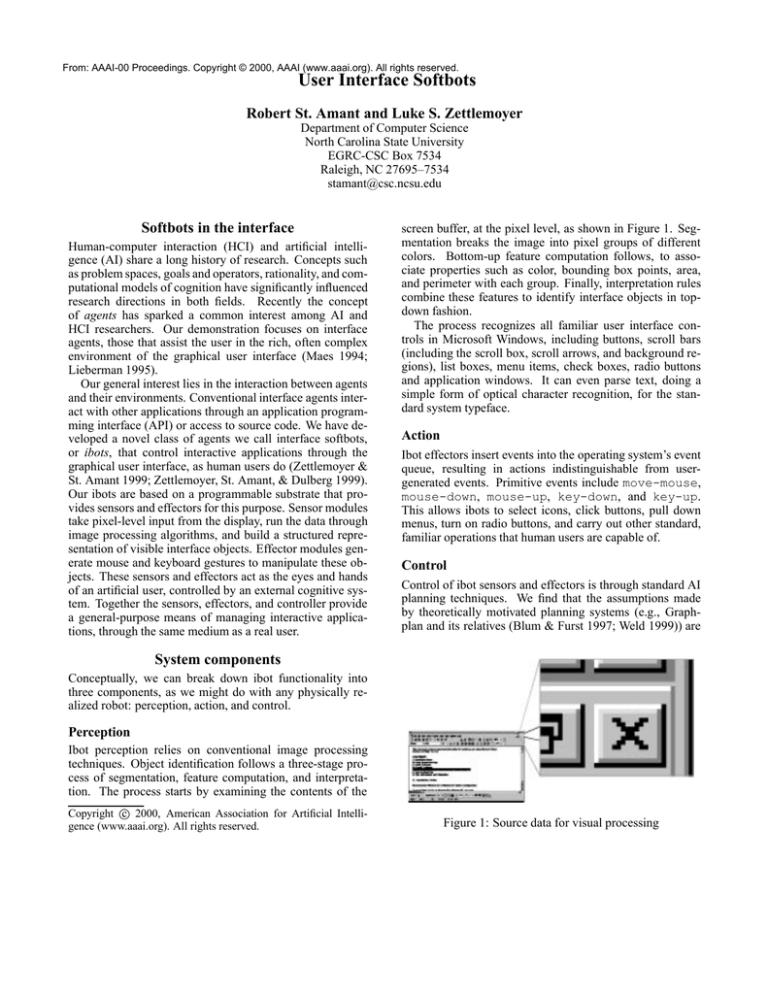
From: AAAI-00 Proceedings. Copyright © 2000, AAAI (www.aaai.org). All rights reserved.
User Interface Softbots
Robert St. Amant and Luke S. Zettlemoyer
Department of Computer Science
North Carolina State University
EGRC-CSC Box 7534
Raleigh, NC 27695–7534
stamant@csc.ncsu.edu
Softbots in the interface
Human-computer interaction (HCI) and artificial intelligence (AI) share a long history of research. Concepts such
as problem spaces, goals and operators, rationality, and computational models of cognition have significantly influenced
research directions in both fields. Recently the concept
of agents has sparked a common interest among AI and
HCI researchers. Our demonstration focuses on interface
agents, those that assist the user in the rich, often complex
environment of the graphical user interface (Maes 1994;
Lieberman 1995).
Our general interest lies in the interaction between agents
and their environments. Conventional interface agents interact with other applications through an application programming interface (API) or access to source code. We have developed a novel class of agents we call interface softbots,
or ibots, that control interactive applications through the
graphical user interface, as human users do (Zettlemoyer &
St. Amant 1999; Zettlemoyer, St. Amant, & Dulberg 1999).
Our ibots are based on a programmable substrate that provides sensors and effectors for this purpose. Sensor modules
take pixel-level input from the display, run the data through
image processing algorithms, and build a structured representation of visible interface objects. Effector modules generate mouse and keyboard gestures to manipulate these objects. These sensors and effectors act as the eyes and hands
of an artificial user, controlled by an external cognitive system. Together the sensors, effectors, and controller provide
a general-purpose means of managing interactive applications, through the same medium as a real user.
screen buffer, at the pixel level, as shown in Figure 1. Segmentation breaks the image into pixel groups of different
colors. Bottom-up feature computation follows, to associate properties such as color, bounding box points, area,
and perimeter with each group. Finally, interpretation rules
combine these features to identify interface objects in topdown fashion.
The process recognizes all familiar user interface controls in Microsoft Windows, including buttons, scroll bars
(including the scroll box, scroll arrows, and background regions), list boxes, menu items, check boxes, radio buttons
and application windows. It can even parse text, doing a
simple form of optical character recognition, for the standard system typeface.
Action
Ibot effectors insert events into the operating system’s event
queue, resulting in actions indistinguishable from usergenerated events. Primitive events include move-mouse,
mouse-down, mouse-up, key-down, and key-up.
This allows ibots to select icons, click buttons, pull down
menus, turn on radio buttons, and carry out other standard,
familiar operations that human users are capable of.
Control
Control of ibot sensors and effectors is through standard AI
planning techniques. We find that the assumptions made
by theoretically motivated planning systems (e.g., Graphplan and its relatives (Blum & Furst 1997; Weld 1999)) are
System components
Conceptually, we can break down ibot functionality into
three components, as we might do with any physically realized robot: perception, action, and control.
Perception
Ibot perception relies on conventional image processing
techniques. Object identification follows a three-stage process of segmentation, feature computation, and interpretation. The process starts by examining the contents of the
Copyright c 2000, American Association for Artificial Intelligence (www.aaai.org). All rights reserved.
Figure 1: Source data for visual processing
closely matched by design features built into graphical user
interfaces. Planners often abstract away the continuous, uncertain, dynamic, and unobservable properties of an environment, such that it becomes discrete, deterministic, static,
and accessible—properties associated with broad classes of
modern graphical user interfaces (St. Amant 1999). In our
most recent work (St. Amant & Zettlemoyer 2000) we have
developed a very simple hierarchical planner to control the
perception and action components of an ibot.
The planner can direct an ibot to take a wide variety of
action sequences, ranging from selecting objects to choosing pulldown menu items to more complex, domain-specific
activities in the interface.
Discussion
We have built ibots for a number of interactive applications,
including a word processor (St. Amant 2000), an illustration
package (St. Amant & Zettlemoyer 2000), the Windows OS
interface (Dulberg, St. Amant, & Zettlemoyer 1999), and
even Microsoft Solitaire (Zettlemoyer & St. Amant 1999).
A generic ibot architecture is shown in Figure 2. The implementation is in C++ and Common Lisp; it bears some
similarity at the most basic level to the Java Robot class.
The work has significant limitations, but progress has been
surprisingly rapid.
Our long-term goal, as stated, is the development of
ibots that can solve real-world problems of significant complexity, those that a user might be interested in to turn
over to an automated system. We have only taken a
few initial steps in this direction. Nevertheless, we have
found ibots to be a flexible, powerful vehicle for agents
research. Our preliminary work has given us insights
in areas such as intelligent interaction mechanisms (Dulberg, St. Amant, & Zettlemoyer 1999), programming by
demonstration (St. Amant et al. 2000), user interface evaluation (Zettlemoyer, St. Amant, & Dulberg 1999), programmable user models (St. Amant, Riedl, & Zettlemoyer
2000), and most importantly the relationship between AI
planning and the user interface (St. Amant 1999; St. Amant
& Zettlemoyer 2000; Zettlemoyer & St. Amant 1999).
We believe that our work on ibots sets the stage, in the
longer term, for agents that can use interactive applications
with all the facility of human users. Consider the humanoriented environments that agents can act in today: robots in
offices, hallways, or on the road, or softbots moving through
file systems and over the Internet. Agents are often at some
disadvantage with respect to their sensing and effecting capabilities in these environments, in comparison with human
agents. In contrast, ibots in the restrictive environment of a
user interface have access to all the same information and
all the same actions that human users have, with little or no
degradation in quantity or quality—the only difference between users and agents in this environment is the knowledge
and cognitive processing power they bring to bear. Our work
will level the playing field for humans and agents solving
real-world problems in an extremely powerful and flexible
environment.
References
Blum, A., and Furst, M. 1997. Fast planning through planning graph analysis. Artificial Intelligence 90:281–300.
Dulberg, M. S.; St. Amant, R.; and Zettlemoyer, L. 1999.
An imprecise mouse gesture for the fast activation of controls. In Proceedings of INTERACT ’99, 375–382.
Lieberman, H. 1995. Letizia : An agent that assists web
browsing. In Proceedings of the International Joint Conference on Artificial Intelligence, 924–929.
Maes, P. 1994. Agents that reduce work and information
overload. Communications of the ACM 37(7):31–40.
St. Amant, R., and Zettlemoyer, L. S. 2000. The user
interface as an agent environment. Forthcoming.
St. Amant, R.; Lieberman, H.; Potter, R.; and Zettlemoyer,
L. S. 2000. Visual generalization in programming by example. Communications of the ACM 43(3):107–114.
St. Amant, R.; Riedl, M. O.; and Zettlemoyer, L. S. 2000.
A practical perception substrate for cognitive modeling in
HCI. Forthcoming.
St. Amant, R. 1999. User interface affordances in a
planning representation. Human Computer Interaction
14(3):317–354.
St. Amant, R. 2000. Interface agents as surrogate users.
Forthcoming.
Weld, D. S. 1999. Recent advances in AI planning. AI
Magazine 20(2):93–123.
Zettlemoyer, L., and St. Amant, R. 1999. A visual medium
for programmatic control of interactive applications. In
CHI ’99 (ACM Conference on Human Factors in Computing), 199–206.
Zettlemoyer, L.; St. Amant, R.; and Dulberg, M. S. 1999.
Ibots: Agent control through the user interface. In Proceedings of the Fifth International Conference on Intelligent User Interfaces, 31–37.
User
Control
Controller
Data
Controller Interface
Image
processing
Sensors
Event
management
Effectors
User interface
Figure 2: A generic ibot architecture

